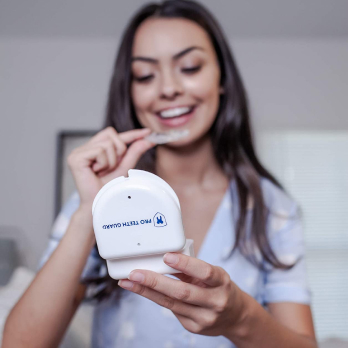Repositioning Splint For TMJ
8th Jan 2022

Temporomandibular joint dysfunction (known as TMD or TMJ) and bruxism are bothersome conditions often treated with occlusal splint therapy. An occlusal appliance or splint is a device you wear in your mouth, and it fits over your bite surface. A popular therapy involves repositioning the jaw into proper alignment with a repositioning splint for TMJ. Once your jaw joint is positioned properly, you should find that many of your TMJ symptoms dissipate.
A repositioning splint is just one option for the management of temporomandibular disorders. Different types of splints are available to treat various TMJ disorders and symptoms. Additionally, a repositioning splint is often used in conjunction with other treatment methods.

What Is a Repositioning Splint for TMJ?
Like other occlusal splints, a repositioning splint (sometimes referred to as an anterior repositioning appliance) is a type of removable mouthguard. These types of splints are usually made of hard acrylic resin.
As its name implies, a repositioning splint is designed to change the position of the lower jaw. The device moves the lower jaw (the mandible) forward or backward into an ideal position. Once the jaw joint is in an ideal position, most symptoms associated with TMJ should go away.
Related Articles:
Repositioning splints are also used to reposition a displaced disc. Anterior disc displacement near the mandibular condyle can cause TMJ symptoms such as pain when chewing or talking, headaches, earaches, orofacial pain, and jaw clicking.
Various types of repositioning splints are useful in treating different TMJ symptoms. For example, an anterior repositioning splint is useful for helping jaw clicking and popping. Because there are various types of dysfunction in the temporomandibular joint, you should not attempt to treat the condition yourself. Your dentist will be able to assess your condition and recommend the correct type of splint for you.
A 2005 paper that aimed to assess the effectiveness of repositioning splint therapy found that the treatment is effective. “90% of the patients experienced a remission of the symptoms and were treated to a generally pain free, functionally satisfactory state,” the author stated (Williamson 2005). Before treatment, these patients experienced various symptoms, including jaw locking, jaw pain, and headaches.

Repositioning Splint vs. Stabilization Splint
Repositioning splints are designed to move the lower jaw while stabilization splints should not move your teeth nor your jaw. Instead, a stabilization splint is designed to protect teeth from the effects of bruxism and TMJ. They reduce tooth clenching and grinding while also relaxing sore jaw muscles. If you find that your stabilization splint is moving your jaw, make an appointment with your dentist to address the problem.
Usually, a stabilization splint covers the upper teeth, although it can sometimes cover the bottom teeth instead. Typically, this device is a maxillary full-coverage splint, meaning it covers all the upper teeth. A repositioning splint is designed to cover the lower teeth.
Related Articles:
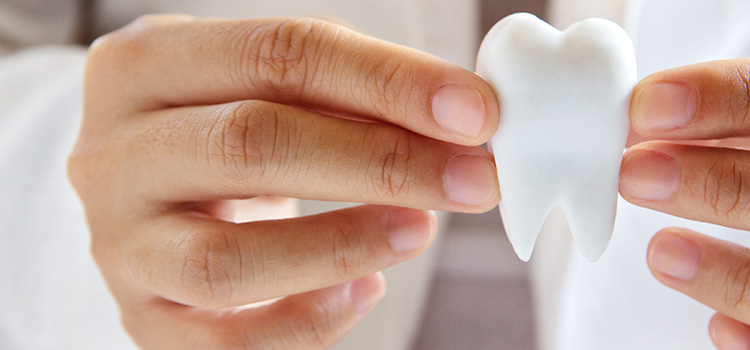
How Do Repositioning Splints Work
Temporomandibular disorders can cause temporomandibular joint disc displacement, jaw position displacement, facial pain, neck and back pain, etc. Jaw misalignment is often the cause of TMJ pain. A repositioning splint works to reduce or eliminate symptoms by moving the displaced joint back into proper alignment.
A study comparing people using repositioning splints to a control group made the following conclusion, “The anterior repositioning splint decreased joint pain at rest, during chewing, and during protrusion. Reciprocal clicking was eliminated and palpatory tenderness of the joint and muscles was reduced” (Lundh et al 1985). The study did find that symptoms returned after stopping treatment, highlighting the importance of following up closely with your dentist when treating TMJ.
Unsurprisingly, you’ll need help from your dentist to get a repositioning splint. He or she will create a custom-fitted splint for you based on your specific symptoms and what needs to be repositioned.
Typically, repositioning splints are not recommended for long term use. The TMJ association states, “Prolonged use (over six weeks) raises the risk of permanent changes in the bite that can be extremely harmful.” Your dentist may recommend a stabilization splint after the repositioning splint has shifted your jaw into ideal alignment.
For splint therapy, regular dentist follow-up visits are also important because repositioning splints have the potential to shift your bite. Your dentist will be able to monitor your jaw movement and assess if You want to make sure that you’re only shifting the parts of your mouth that should be shifted.
When to Use a Repositioning Splint
Repositioning splints should be used when you have symptoms of TMJ and when your dentist determines that this is the correct treatment for you. TMJ appliance therapy can reduce or eliminate your symptoms by shifting your jaw back into proper alignment or correcting disk displacement. By working closely with your dentist, a repositioning splint can treat your TMJ and improve your quality of life.
Other types of occlusal splints, such as stabilization splints serve different purposes. If you have bruxism, a night guard is likely the right option for you. At Pro Teeth Guard, you can get a custom-fit night guard at an affordable price. We make our night guards in a professional dental lab, and every night guard is guaranteed to fit comfortably with our 110% money-back guarantee.
References:
- Lundh, H., Westesson, P. L., Kopp, S., & Tillström, B. (1985). Anterior repositioning splint in the treatment of temporomandibular joints with reciprocal clicking: comparison with a flat occlusal splint and an untreated control group. Oral surgery, oral medicine, and oral pathology, 60(2), 131–136. https://doi.org/10.1016/0030-4220(85)90280-4
- TMJ Association Writing Staff. (2021). Splints. The TMJ Association. https://tmj.org/living-with-tmj/treatments/splints/
- Williamson E. H. (2005). Temporomandibular dysfunction and repositioning splint therapy. Progress in orthodontics, 6(2), 206–213. https://pubmed.ncbi.nlm.nih.gov/16276429/

- Most Popular
- Hard Outside, Soft Inside
- 2MM Thick
- Moderate / Heavy
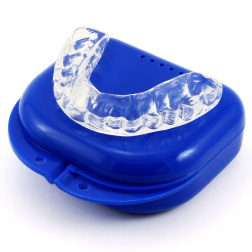
- Most Durable
- Hard Materials
- 1.5MM Thick
- Heavy / Severe
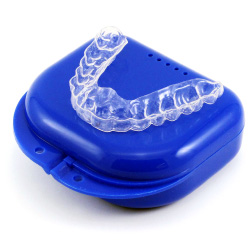
- For Day Time Use
- Thin, Barely Visible
- 1MM Thick
- Light / Moderate
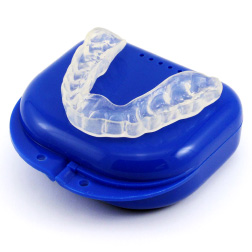
- For Clenching
- Flexible & Soft
- 1.5MM Thick
- Light / Moderate

